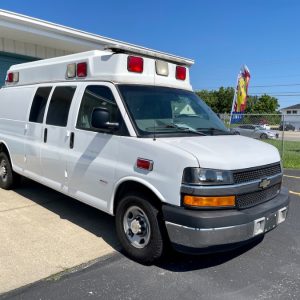Electric ambulances represent an exciting innovation in emergency medical transportation. Though still relatively new, electric ambulance technology offers a number of potential benefits compared to traditional gas-powered models.
The concept of an electric ambulance dates back to the late 1800s. As early electric vehicles were developed, some entrepreneurs realized that the technology could be applied to ambulance services. However, it wasn’t until the 1990s that production electric ambulances really became feasible. Advancements in battery technology finally enabled electric vehicles to achieve the range and power needed for emergency response.
Today, a growing number of ambulance manufacturers offer electric models, including industry leaders like Frazer Ltd. What makes electric ambulances so appealing? For starters, they produce zero direct emissions, which is better for the environment and public health. Electric motors are also quieter than loud gas engines, an important factor for patient comfort. Maintenance costs may be lower as well since electric vehicles have fewer moving parts.
Of course, electric ambulances still face some limitations in range and charging infrastructure. But manufacturers continue to make improvements to battery technology. As more cities and healthcare providers adopt electric fleets, the benefits will become even clearer. Electric ambulances represent an exciting way to provide carbon-free emergency transportation.
How Electric Ambulances Work
They are powered by an electric drivetrain instead of an internal combustion engine. Here are some key components and features:
- Electric Motor: The motor converts electrical energy from the battery into mechanical power to turn the wheels. Electric motors provide instant torque and smooth acceleration.
- Battery: The large battery pack stores energy to power the electric motor. Battery size determines driving range. Batteries can charge from a wall outlet or fast charging station.
- Control Systems: Sophisticated control systems optimize battery efficiency and performance. Regenerative braking recharges the battery by capturing energy when braking.
- Range and Charging: Electric ambulances typically have 100-200 mile range per charge. They can be slowly charged overnight or fast charged in 1-2 hours. Ranges continue improving with battery tech.
- Safety and Redundancy: Electric ambulances have backup battery reserves and systems to ensure critical medical equipment remains powered. Some have noise-cancelling tech for patient comfort.
- Low Maintenance: Electric motors have fewer moving parts and require less maintenance than internal combustion engines. No oil changes needed! Cost savings over the lifetime of the vehicle.
Electric drivetrains provide a smooth, quiet, and emissions-free ambulance experience. As battery tech improves, electric ambulances will continue gaining popularity.
Benefits of Electric Ambulances
They offer several key benefits compared to traditional gas or diesel-powered models. Some of the main advantages include:
Lower Maintenance Costs
Electric vehicles have far fewer moving parts than internal combustion engine vehicles. Without components like complex transmissions, mufflers, and exhaust systems, electric ambulances have reduced maintenance requirements. Brake repairs are also less frequent due to regenerative braking that converts kinetic energy back into electricity. Overall, electric ambulances can save significantly on maintenance and repair costs over the lifetime of the vehicle.
Reduced Noise Pollution
Ambulances with loud sirens and diesel engines contribute to environmental noise pollution, especially in dense urban areas. Electric ambulances produce very little noise when operating, greatly reducing noise impacts on the community. Patients, EMTs, and bystanders also benefit from quieter rides.
Lower Emissions
They have zero tailpipe emissions, meaning they don’t emit greenhouse gases or other pollutants that contribute to smog and respiratory health issues. As electric grids transition to renewable energy, electric ambulances will have an even lower carbon footprint. This makes them ideal for environmentally conscious cities and health organizations.
Potential Fuel Savings
While electricity prices fluctuate, they are often lower and more stable than gasoline and diesel fuel costs. Charging electric ambulances is typically cheaper per mile than refueling them with fossil fuels. Organizations that run They can realize significant savings on fuel over time, especially those that charge during off-peak hours.
Challenges of Electric Ambulances
They offer many benefits, but they also come with some unique challenges that need to be addressed.
Higher Upfront Costs
The most obvious drawback of electric ambulances is that they currently cost more than diesel or gasoline models. The battery packs and electric powertrains add considerable expense compared to internal combustion engines. This means that purchasing an electric ambulance requires a greater upfront investment. However, electric vehicles offer fuel and maintenance savings over time that can offset the higher initial cost.
Limited Range and Charging Infrastructure
Today have a range of 100-200 miles on a single charge. This is sufficient for most daily operations, but not ideal for rural areas. Limited range gives ambulance crews less flexibility and requires careful route planning. Expanding public charging networks can help, but dedicated charging stations may be needed at ambulance depots. Building out this infrastructure takes time and money.
Unknown Long-Term Battery Lifespan
Standard lithium-ion batteries gradually degrade over years of use. Replacing battery packs adds another cost consideration. The lifespan of batteries in electric ambulances is still unknown since the vehicles are so new. There are concerns about battery degradation affecting range as ambulances age. More data is needed on real-world battery performance over an ambulance’s life cycle.
Cold Weather Performance
Extreme cold temperatures can reduce an EV’s range by up to 40%. This makes operating electric ambulances more difficult in frigid winter climates. Battery performance and interior heating in the patient cabin are concerns. Strategies like battery thermal management and preheating while plugged in can help maximize cold weather range. Despite precautions, They may be impractical in some very cold regions.
Overcoming these challenges will be key for electric ambulances to gain wider adoption. But manufacturers are actively working on solutions, and the technology is rapidly improving.
Major Manufacturers
The market is still relatively new, but some major manufacturers have emerged as leaders in producing these innovative vehicles. Here’s an overview of several notable companies in this space:
REV Group
REV Group is one of the largest manufacturers of specialty vehicles, including ambulances. They offer two models:
- E-One Typhoon eSV: Built on a Ford Transit chassis, this Type I ambulance has a 56-mile electric range. It uses a Phoenix Drive electric drivetrain.
- Horton Emergency Vehicles REV Ambulance: This Type III ambulance is built on a Chevrolet Bolt chassis and has a 250-mile electric range. It uses an electric drivetrain from Lightning eMotors.
REV Group They are used by private ambulance services and municipalities including Orlando Fire Department and American Medical Response.
Braun Industries
Braun Industries, a major ambulance manufacturer, offers the Braun Northwest eVX Type I electric ambulance. It’s built on a Ford E-450 chassis and has a 100-mile range. Key customers include Tri-Hospital EMS and Superior Ambulance Service.
Rosenbauer
Rosenbauer, an Austrian company, produces the Revolutionary Technology (RT) electric ambulance. It’s built on a Volvo chassis and has a 150-mile range. Rosenbauer has deployed electric ambulances to customers worldwide, including in Berlin, Amsterdam, and Dubai.
Leader Industries
Leader Industries offers the Eco Ambulance line which includes Type I, Type II, and Type III electric models. They utilize Azure Dynamics electric drivetrains and have a range of up to 100 miles. Leader electric ambulances are used by municipalities like the city of Sacramento.
Frazer
Frazer manufactures the Frazer EV Type I and Type III electric ambulances. They have a 100-mile range and use electric drivetrains from Lightning eMotors. Frazer has provided electric ambulances to customers including the city of Santa Monica.
Case Studies and Examples
They are still relatively new, but some cities and services have started adopting them and seeing benefits.
London Ambulance Service
The London Ambulance Service introduced two fully electric ambulances in 2020. These ambulances have a range of around 100 miles on a single charge. The service found the electric ambulances reduced noise pollution and exhaust fumes compared to diesel models. Drivers reported the electric ambulances had excellent acceleration and hill climbing ability. The only downsides were the charging requirements and slightly reduced range compared to diesel. But overall, the trial was a success.
Austin-Travis County EMS
Austin-Travis County EMS in Texas brought in 3 electric ambulances starting in 2018. They found the electric motors provided smooth, quiet, and emissions-free operation. The fast torque also improved acceleration. Charging infrastructure was installed at ambulance stations. While range was a bit lower than diesel, the electric ambulances served well for most emergency calls. Austin sees electric ambulances as the future and will transition more of its fleet over time.
Key Takeaways
The case studies show electric ambulances provide environmental and performance benefits over diesel models. Range can be a limitation but works for most calls. More charging infrastructure is needed. Overall, They are a promising green technology for emergency medical services. More cities will likely transition as the technology matures.
Electric Ambulance Costs
The upfront purchase price of an electric ambulance is typically higher than a comparable gas-powered model. However, They offer significant savings on fuel and maintenance over their lifetime.
The initial cost premium over gas-powered ambulances can range from $50,000 to $100,000 or more. But electric models eliminate spending on gasoline, reduce brake and transmission maintenance, and have 30% fewer parts overall. These factors lead to dramatically lower operating costs that offset the higher sticker price.
One analysis by the Center for Transportation and the Environment estimated that over the 12-year lifespan of an ambulance, an electric model can save between $400,000-$800,000 compared to a diesel ambulance. These savings come from reduced fuel and maintenance costs.
There are also government incentives available to help offset the initial cost premium of electric ambulances. States like California and New York offer voucher programs worth $50,000 or more per electric ambulance purchased. The federal government also provides a tax credit up to $7,500 for buying a new electric vehicle.
Utilizing these incentives in combination with the fuel and maintenance savings makes electric ambulances cost-competitive with gas-powered models over the long run. The environmental benefits of zero-emissions electric vehicles further add to their value proposition for ambulance fleets.
Charging Infrastructure Needed
They require robust charging infrastructure to keep them powered and in service. There are two main options for charging – Level 2 AC charging and DC fast charging.
Level 2 charging provides up to 19.2 kW of power and can fully recharge an ambulance battery overnight. These stations cost around $3,000-6,000 to purchase and install. They are best suited for ambulance headquarters and stations where vehicles are parked for longer periods.
DC fast charging can provide 50-350 kW to quickly top off ambulance batteries in about 30 minutes. These high powered stations cost $50,000-$100,000. They are ideal for locations where ambulances need to charge while out on calls, such as hospitals.
Experts recommend a ratio of around one charger for every 2-3 electric ambulances. Charging stations should be installed at ambulance stations, hospitals, and strategic locations throughout the service area to enable efficient charging while in use.
With careful planning of charging infrastructure, They can stay charged and ready to respond to emergencies at all times. Sufficient Level 2 and DC fast chargers are key to successful electrification of ambulance fleets.
The Future of Electric Ambulances
The future looks bright for They as the technology continues to improve. Here are some key trends to watch:
Improving Battery Technology
Lithium-ion batteries are becoming cheaper and more energy dense each year. This allows electric ambulances to travel farther on a single charge. New battery chemistries like solid state batteries promise even greater range and faster charging in the future.
Expanding Charging Infrastructure
More charging stations, especially DC fast charging, will make it easier for ambulances to stay charged up. Charging networks are expanding rapidly, helped by government funding and utility investments. This makes electric ambulances more practical over a wider service area.
Transition Goals and Regulations
Many jurisdictions have set goals to transition their ambulance fleets to electric over the next 10-20 years. This is driven by emissions reduction targets and a desire to improve local air quality. Regulations may also eventually prohibit purchasing new diesel ambulances.
Autonomous Driving
Self-driving technology could be a game changer for ambulances. This would allow them to drive themselves to charging stations and drive more efficiently to conserve battery. It also makes remote operation possible for low acuity transfers. Full autonomy is still years away but holds much potential.
In summary, electric ambulance technology will continue improving while costs come down. This will make them a mainstream choice for emergency medical services seeking to upgrade their fleets.
Conclusion
They offer several potential benefits over traditional diesel models, including reduced emissions, lower maintenance costs, and quieter operation. However, they also come with challenges such as limited range, long charging times, and high upfront costs.
Key points in summary:
- Electric ambulances produce zero tailpipe emissions, which can improve local air quality and public health. Diesel exhaust contains harmful pollutants.
- The electric motors require less maintenance than diesel engines and have lower fuel costs per mile. However, battery replacements may be expensive.
- Electric ambulances operate very quietly, which allows for better communication and less noise disturbance. Diesel engines can produce up to 90 decibels of noise.
- Range is currently limited to around 100-150 miles on a single charge due to battery size constraints. Careful route planning is necessary to avoid running out of charge mid-trip.
- Charging can take 8+ hours using Level 2 charging. Fast charging capability would enable more flexibility but adds infrastructure costs.
- The high initial cost of electric models, largely due to the battery, may deter some buyers. However, operational savings over the lifespan can offset the upfront price premium.
The case for adopting electric ambulances depends on the use case and budget. For urban areas with access to fast charging, they offer clear efficiency and environmental gains. As costs decrease and charging networks expand, they will become viable for more locations. What’s next is continuing to improve range, charging speed, and affordability.







































